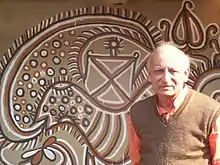Sohrai
Sohrai is a harvest festival of the Indian states of Bihar, Jharkhand, Chhattisgarh, Odisha, and West Bengal. It also called cattle festival. It is celebrated after harvest and coincide with festival of Diwali. It is celebrated by Prajapati, Kurmi, Santal, Munda and Oraons among others.[1][2]
| Sohrai | |
|---|---|
| Also called | Bandna |
| Type | Cultural, seasonal |
| Celebrations | Diya, home decoration, performing rituals and feast |
It is celebrated on Amavasya of the Hindu month Kartik in the month of October–November. In some region it celebrated also in mid January. In this festival, people fast, paint house, prepared food. In night, they light earthen lamps in the cattle-sheds and offered sacrifice to deity of animals Gaurea also known as Pasupati.[3][4]
Celebration
Sohrai is harvest festival celebrated after harvest. The festival is celebrated on Amavasya(new moon) in the Hindu month of Kartik(October-November). The feast is celebrated in the honour of cattle especially bullocks, buffalos, goats and sheep. On the day earthen lamps lits on homes, cattle sheds, kitchen and garden. On the festival day, those animals are bathed, their horn and foreheads are anointed with vermillion diluted in oils. They are offered special food of rice and vegetables. Sacrifice is offered to deity Gaurea(Spirit of cowshed). Sohrai is day to express gratitude and affection for livestocks.[4][5][6][7] The harvest festival is the time of the year when they exhibit their artistic skills and expressions. Every year, after the festival is over, the drawings and patterns created during this time are erased. This festival usually takes place in the month October or November for three days. The festival coincide with Diwali.[8] Sohrai is the chief festival of Santhal tribe held in after the chief rice crop of the year has been got in.[9]
Arts
In Hazaribagh district of Jharkhand, an indigenous art form is practised by the women. Ritualistic art is done on mud walls to welcome the harvest and to celebrate the cattle. The women clean their houses and decorate their walls with murals of Sohrai arts. This art form has continued since 10,000-4,000 BC. It was prevalent mostly in caves, but shifted to houses with mud walls.[10]

This Sohrai art form can be monochromatic or colorful. The people coat the wall with a layer of white mud, and while the layer is still wet, they draw with their fingertips on it. Their designs range from flowers and fruits to various other nature-inspired designs. The cow dung that was earlier used to cake the walls of the house is used to add colour. The dark outline is visible due to the previously applied contrasting white mud coat. Sohrai artists are spontaneous in their drawing. Little pre-planning is evident. The canvases range up to 12 x 18 feet..The designs are usually drawn from the artist's memory. The personal experience of the artist and their interaction with nature are the biggest influence.
References
- "SOHRAI: THE TRADITIONAL HARVEST ART OF JHARKHAND". shuru-art.com.
- "Sohrai, A festival and an art". indroyc.com. 10 November 2015.
- "SOHRAI PAINTING". maatighar.org.
- Xalxo, Prem (2007). Complementarity of Human Life and Other Life Forms in Nature: A Study of Human Obligations Toward the Environment with Particular Reference to the Oraon Indigenous Community of Chotanagpur, India. Gregorian Biblical BookShop. p. 58. ISBN 978-88-7839-082-9.
- Sevartham. St. Albert's College. 2005. p. 28.
- Xalxo, Prem (2007). Complementarity of Human Life and Other Life Forms in Nature: A Study of Human Obligations Toward the Environment with Particular Reference to the Oraon Indigenous Community of Chotanagpur, India. Gregorian Biblical BookShop. ISBN 978-88-7839-082-9.
- Sachchidananda (1979). The Changing Munda. Concept. p. 291.
- Krishna, Sumi (13 January 2004). Livelihood and Gender: Equity in Community Resource Management. SAGE Publications India. p. 268. ISBN 978-81-321-0385-1.
- Gupta, Narendra Kumar Das (1963). Problems of Tribal Education and the Santals. Bharatiya Adimjati Sevak Sangh. p. 50.
- 1949-, Singh, Ajit Kumar (1997). Land use, environment and economic growth in India. MD Publ. ISBN 8175330252. OCLC 313224070.CS1 maint: numeric names: authors list (link)
